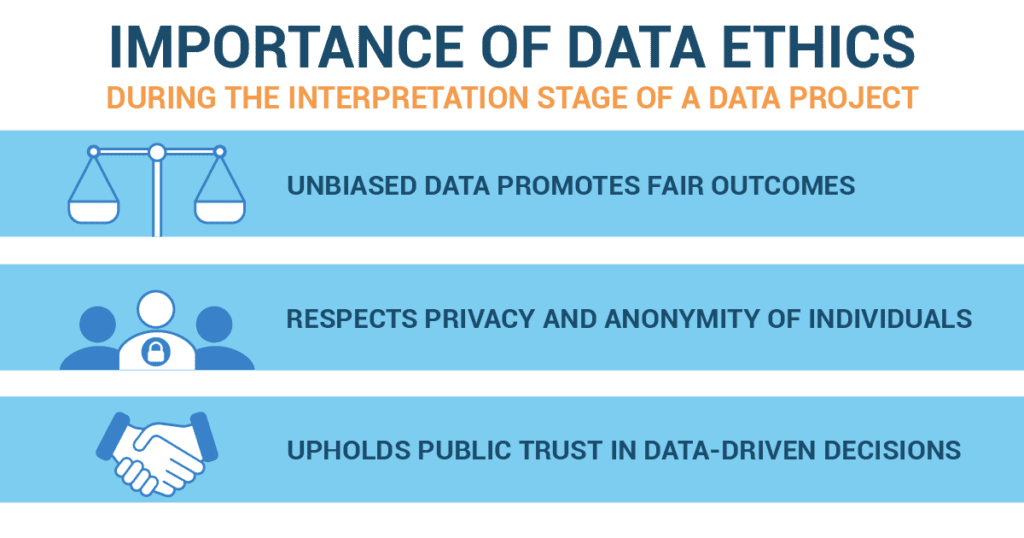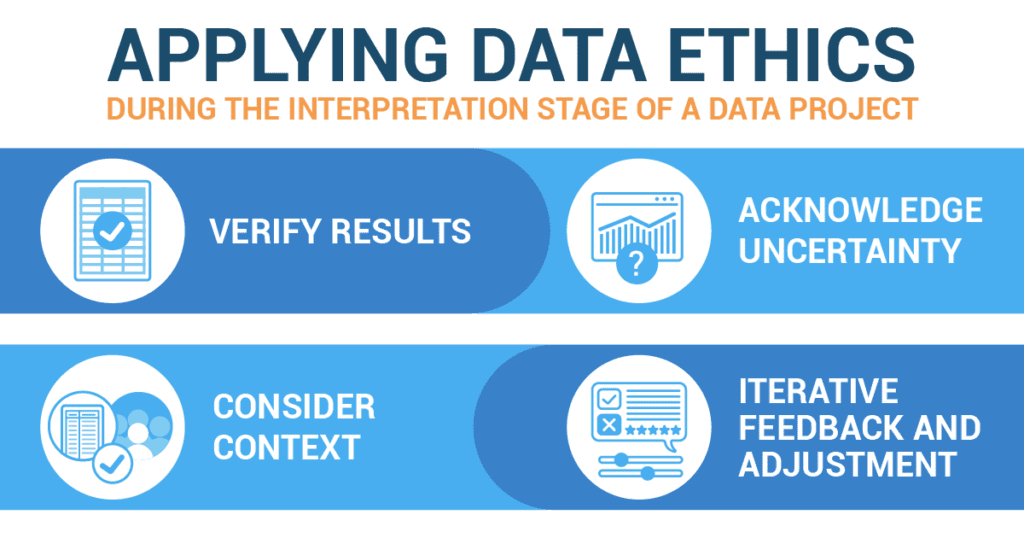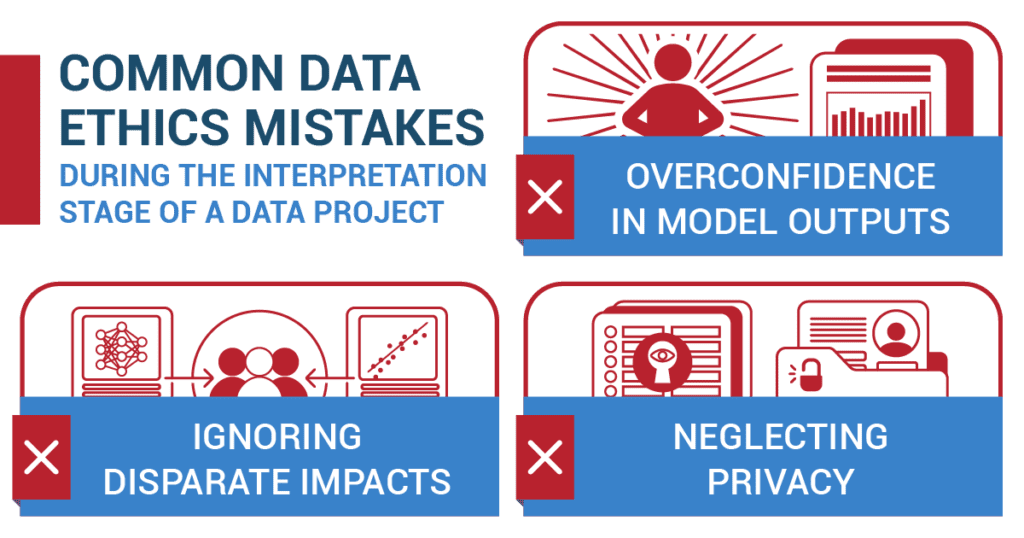Imagine you’re deciding which local spot would be the best for a group hangout. Now, imagine if you had to make that choice not just for you and your friends, but for your entire company or even your town. The stakes suddenly rise, don’t they?
Now, let’s add another layer. Imagine you have some insider info—data that tells you which movie most teens love, or which hangout spot is trending among people in their 20s. Seems a bit easier to decide, right? But here’s the catch: what if that data is biased? What if it’s influenced by unfair factors or doesn’t consider everyone’s preferences?
Why do we need data ethics?

Let’s imagine this: you’re coaching a volleyball team, and your team line-up should be based on players’ speed, height, and strength statistics. But what if the equipment used to measure these statistics was faulty? It might lead to a star player being benched and a critical game being lost.
- The conclusions drawn from a dataset directly influence decisions that can have significant societal impacts. If data is misinterpreted or biases are not accounted for, these decisions can lead to unfair or harmful outcomes.
- Interpreting data, especially in sensitive areas, requires respect for privacy. The data should be interpreted in a way that does not compromise the privacy and anonymity of individuals.
- Responsible data interpretation encourages transparency and accountability, maintaining public trust in data-driven decisions.
How to Apply Data Ethics

Applying data ethics when interpreting data is a bit like using a safety helmet while cycling. It protects us and those around us. Here’s how you do it:
First, verify the results. It’s like a ‘double-check’ system. When your colleagues tell you about a new, awesome burger joint, you’d probably check a few more reviews before trying it out, right? Similarly, always cross-check your data with different techniques or datasets to make sure it’s reliable.
Next, always acknowledge uncertainty. Think of it like the weather forecast. The news tells us there’s a 70% chance of rain. They’re acknowledging that their prediction might not be perfect. In the same way, be transparent about where your data might have limitations or potential errors.
Don’t forget to consider the context. Suppose you’re deciding on the best time to hold an event. You wouldn’t just look at your own schedule, right? You’d consider everyone else’s schedules, too. The “Fairness, Accountability, and Transparency in Machine Learning” (FATML) framework advises us to consider the context in which the model will operate and to consider possible disparate impacts on different demographic groups. So, you think about who your data affects and how it affects them.
Common Mistakes in Data Ethics

- Overconfident in your model outputs.
- While it is important to ground decision-making on analysis, it is also important to not become over-reliant on those outputs.
- Countermeasure: Always consider model outputs as probabilistic and uncertain, disclosing and considering potential errors and limitations. Remember, data is like the weather forecast; it’s not always 100% accurate.
- Ignoring Disparate Impacts
- Unfair outcomes and discrimination can occur if you ignore the impact on different groups.
- Countermeasure: Use techniques such as disparate impact analysis or fairness metrics to identify and mitigate potential biases in model outputs. It is like when you organize a party, you need to make sure there’s food that everyone can eat. Some might be vegetarians, some might be allergic to peanuts. Similarly, make sure your data interpretation is fair to everyone.
- Neglecting Privacy
- Unintentional disclosure of sensitive information during the interpretation stage can violate privacy rights.
- Countermeasure: Make sure you protect the sensitive information in your data by using privacy-preserving techniques, such as differential privacy, and adhere to data minimization practices to ensure only necessary data is used and disclosed.
Ethical Interpretation in Leather Products Data Project
Amid the world of leather products, Jennifer Turner, a seasoned corporate professional, found herself immersed in a data project that sought to combine data-driven insights with ethical considerations. Her journey revolved around the intricate dance of interpreting data to create innovative leather goods while upholding the highest standards of data ethics.
Jennifer’s project was ambitious – to utilize data analytics to optimize the design and production of leather goods, from handbags to shoes. Recognizing the potential ethical implications of data interpretation, she aimed to ensure that every decision made based on data insights was rooted in ethical principles. During the interpretation stage of the project, Jennifer diligently integrated ethical practices to ensure that the insights gleaned from data were used in a responsible, inclusive, and respectful manner.
Understanding the sensitivity of the leather industry, Jennifer took steps to ensure that the marketing strategies arising from data insights were responsible and accurate. She avoided any marketing claims that might inadvertently mislead consumers or exaggerate the benefits of leather products, thereby maintaining transparency and integrity. Recognizing the environmental concerns associated with leather production, Jennifer focused on interpreting data that emphasized sustainable practices. She worked closely with sustainability experts to ensure that any insights derived from data contributed to the reduction of environmental impact, thus aligning her interpretations with ethical considerations.
Jennifer was keenly aware that the leather goods industry catered to diverse consumer preferences. She applied her corporate insight to interpret data in a way that acknowledged individual tastes and preferences, ensuring that the final products were versatile and inclusive. This approach resonated with ethical considerations that value diversity. The leather industry often intersects with cultural sensitivities. Jennifer took extra care to interpret data in a way that respected the beliefs and values of various cultures. This included avoiding designs or practices that might be offensive or culturally inappropriate, thereby aligning her interpretations with ethical and cultural awareness.
Incorporating her corporate communication skills, Jennifer emphasized the importance of transparent communication in her interpretations. She ensured that any conclusions drawn from data were communicated with honesty and accuracy, avoiding any misrepresentation that could damage consumer trust. Jennifer leveraged her corporate network to form partnerships with ethical leather suppliers and artisans. She ensured that her data interpretations aligned with supporting fair labor practices and responsible sourcing, contributing to the overall ethical stance of her project.
As the interpretation phase concluded, Jennifer’s ethical approach left an indelible impact on the project. The leather products that emerged were not only aesthetically appealing but also ethically responsible. Her case study exemplifies the harmonious blend of innovation and ethics, illustrating how a corporate professional can drive positive change in an industry while upholding ethical standards. Jennifer Turner’s journey in the world of leather products, enriched by her corporate experience, stands as a testament to the power of ethical data interpretation. Her case study underscores the significance of maintaining ethical considerations in all stages of data projects, particularly in industries as complex and multifaceted as leather goods.